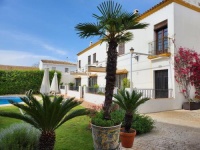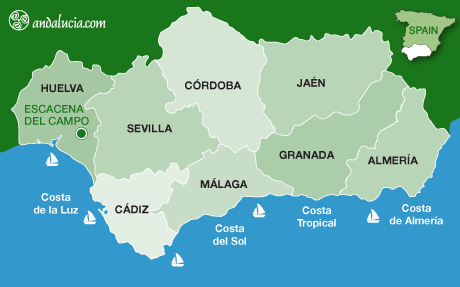Escacena del Campo
by Saskia Mier
Escacena del Campo is the most eastern village of the province of Huelva and offers landscapes painted with fields of sunflowers, cereals and olive trees. Close by is Pata del Caballo, a natural area with a large population of wild boars. It currently has about 2.200 inhabitants.
HISTORY
Escacena del Campo has archaeological remains dating back to the Bronze Age, long before the Roman occupation. Turdetanos, Phoenicians, Carthaginians and eventually the Romans settled around the area, not forgetting the two settlements of Tejadas.
Tejada la Vieja was founded by Tartessos and the settlements consisted of huts and were dedicated to farming activities. However, intense metallurgical activity that developed in this area led to the construction of a major city in the eighth century B.C.eventually becoming a commercial centre, distributing goods from mining areas. Tejada la Vieja was centred on the collection, handling and marketing of silver, copper and lead, which was transported to the Rio Guadiamar, and from there to the coast.
From the sixth and seventh centuries B.C. ceramic pieces have been found of Phoenician origin. In the second half of sixth century B.C. Escacena del Campo suffers an economic crisis and its inhabitants leave to more favourable places like Tejada la Nueva. Tejada la Nueva became one of the most important cities during Roman ruling under the name of Ituci. According to legend, Empress Pompeia Plotina was born in Tejada la Nueva, who acquired the title when she married the Trajan Emperor. Thus, the name Escacena coming from the Latin term "scatius", referring to one of the villages that existed in the area.
Under Visigoth ruling, the area suffered a decline, until Moorish occupation, around the year 713. In the seventh century, walls were rebuilt and expanded almost twice the original extension. Water mills were built and orchards created.
In 1253, Tejada belonged to the Christians going and depended on the city of Seville. There is evidence to show a battle during this period, to which the Moors were defeated at a place known as "Cerro de la Matanza".
Until the nineteenth century, Escacena del Campo belonged to Seville until 1833, when the province of Huelva was created and Escacena del Campo became dependent on it.
THINGS TO SEE
Iglesia Parroquial del Divino Salvador
The Baroque church dates back to the sixteenth and eighteenth centuries. The image of Christ and the Vera-Cruz are both from the eighteenth century. The main altarpiece dedicated to Salvador, was conducted in the late eighteenth century and the image of Sagrado Corazón de Jesús from the nineteenth century. Located on Calle Virgen de Luna.
Ermita de San Isidro Labrador
The chapel dates to 1959 located next to the remains of Tejada la Nueva. Its interior holds the image of San Isidro Labrador and Virgen de Luna (1.22 m), patroness of Escacena, made by Barbero Medina in the mid-40s. Located in Tejada la Nueva.
Ermita Santa Cruz de Abajo
Ermita Santa Cruz de Abajo was built in 1980 by Don Anastasio Martinez Cerro and the iron gates were made in the workshop of José Fernandez Diaz. Located on Calle Rábida.
Convento Santa Ángela de la Cruz
Former convent of Hermanas de la Cruz built in the first third of the twentieth century and currently used as a nursing home. A simple two floored design, the convent holds the images of Sagrado Corazón de Jesús, Inmaculada Concepción and San José. Located on Calle Tejada.
Estación de Trenes
This railway station was built in 1880 by the company M. Z. A., like many others on the Sevilla-Huelva line, all of Neomudéjar design, like those of La Palma del Condado or Villarrasa. Located on Carretera Estación, HV 7008.
Yacimiento Tejada la Nueva
The archaeological site of Tejada la Nueva is still visible today, showing the wall that surrounded the ancient metallurgical centre. These belong to two overlapping stages: the oldest, Roman, still shows the formation of "opus quadratum", the second phase is "almohade". Locatedon Carretera Escacena-Aznalcóllar, 5,5kms from Escacena del Campo.
Yacimiento Tejada la Vieja
One of the most characteristic elements of this archaeological site is the wall that surrounds it, which is partially excavated and visible at several points. There are also some visible foundations where public buildings, warehouses, bakeries and bread ovens once stood. All this suggests that Tejada became an organized town whose economy reached boom thanks to trade with the Phoenicians. Locatedon Carretera Escacena del Campo-Aznalcóllar, 10kms from Escacena del Campo.
Fuente El Atanor
The water source of Atanor supplied an ancient monastic community, in this case Franciscanos de Observancia, established after 1453. However, the date shown on Fuente El Atanor is 1943 and has a ceramic piece with the image of Nuestra Señora De Luna.
Fuente de la Cañería
Fuente de la Cañería is a water source built in the fifteenth century by Carmelite monks who lived in Prado de Luna.The water comes from a nearby spring to Paterna del Campo and channelled through to Escacena del Campo. During the eighteenth century it underwent restoration. Located in Camino Cañería.
La Pata del Caballo
La Pata del Caballo is an estate of over 7,000 hectares, belonging to Escacena del Campo. It was repopulated years ago with pine trees and eucalyptus, but preserving the native oak forest.Unfortunately, the wildlife, especially large mammals (deer and wild boar) that lived in this area have mostly disappeared, although some can still be spotted in the mountains. As for birds, the booted eagle, the short-toed eagle, buzzards, black stork etc can all be seen. Alto del Cejo is an important viewpoint, and from here you can observe much of Huelva's countryside and the Aljarafe (Seville). Located north east of Escacena del Campo.
Hotels near Escacena del Campo
Book Hotels near Escacena del Campo
COUNTRYSIDE WALKS
Escacena-Paterna del Campo
The route begins in Escacna del Campo and travels north and then west in a circular shape back to Paterna del Campo. It is 15kms in length and has duration of 1½ hours. During the route, you pass Ermita de San Isidro Labrador and Fuente del Fraile.
Tejada La Nueva-Tejada La Vieja
The route begins in Tejada La Nueva and heads north Tejada La Vieja. It is 8.3kms in length and has duration of 1 hour.
GASTRONOMY
The most characteristic product of Escacena del Campo is the chickpea, therefore the most popular dish is potaje de grabanzos, which is accompanied by vegetables, meat and "pringá" made with chorizo, blood sausage and bacon. As for sweet treats, there are many traditional pastries to try, such as orejas de abad, made from flour and brandy, specially prepared at Easter. Other sweets include pestiños, piñonates, both dipped in honey.The rice pudding is also very traditional in Escacena del Campo. Typially, Escacena del Campo is famous for ayuyas, based on raw bread dough that is crushed with a rolling pin, cut into small pieces, fried and rolled in sugar and cinnamon.
HANDICRAFTS
Traditional crafts include household utensils made of palm or wicker, a very laborious art in which the esparto is sewn and pressed to make mats, baskets, blinds etc. Saddlery is also very popular as is the manufacturing of leather good in general, such as belts, bags and accessories. Escacena del Campo also offers embroidery and crochet, specifically gold and silk embroidery.
FESTIVALS
Los Tostones
Held in early February, it is a gastronomic event to raise funds for the Brotherhoods of San Isidro and El Rocio. The main dish is tostón, a toasted bread smeared with garlic and oil accompanied by sardines.
Garbanzada Popular
Celebrated in late March at the fairground "José María Cerero Sola"and is celebrated as a small trade fair marketinglocal products.
Romeria de San Isidro Labrador
Celebrated around the 15 May, the pilgrimage dedicated to San Isidro takes place in Tejada la Nueva. There is also an intense weekend full of events including "pescaitofrito", where fried fish is served to everyone.
Fiestas Patronales en Honor a Nuestra Señora Santisima Virgen de Luna
Held in mid-August, in honour of Virgen de Luna. The whole week is packed with activities and events.
Día de la Inmaculada Concepción de María
Celebrated 8 December. Some 45 years ago, this seventeenth century Virgin was taken through the streets and had an accident, damaging the image that was later restored by sculptor José María Cerero. From then on, there are no processions of this image.
LOCATION
Escacena del Campo is located 61km from Huelva. To get there. take the H-31 leaving Huelva towards Seville. Continue on the A-49, take Exit 34 and pass through Chucena on the A-481. Take a left turn onto the A-472, then the first right turn onto the HU-6111 to Escacena del Campo.


